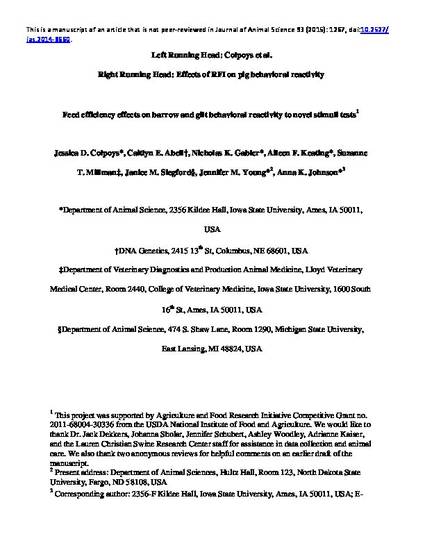
Increasing feed efficiency is an important goal for improving sustainable pork production and profitability for producers. To study feed efficiency, genetic selection based on residual feed intake (RFI) was used to create 2 divergent lines. Low-RFI pigs consume less feed for equal weight gain compared to their less efficient, high-RFI counterparts. Therefore, our objective was to assess how a pig’s behavioral reactivity toward fear-eliciting stimuli related to RFI selection and improvement of feed efficiency. In this study, behavioral reactivity of pigs divergently selected for RFI was evaluated using human approach (HAT) and novel object (NOT) tests. Forty low-RFI and 40 high-RFI barrows and gilts (n = 20 for each genetic line; 101 ± 9 d old) from ninth-generation Yorkshire RFI selection lines were randomly selected and evaluated once using HAT and once using NOT over a 2-wk period utilizing a crossover experimental design. Each pig was individually tested within a 4.9 × 2.4 m test arena for 10 min; behavior was evaluated using live and video observations. The test arena floor was divided into 4 zones; zone 1 being oral, nasal, and/or facial contact with the human (HAT) or orange traffic cone (NOT) and zone 4 being furthest from the human or cone and included the point where the pig entered the arena. During both HAT and NOT, low-RFI pigs entered zone 1 less frequently compared to high-RFI pigs (P ≤ 0.03). During NOT, low-RFI pigs changed head orientation more frequently (P = 0.001) but attempted to escape less frequently (low-RFI = 0.97 ± 0.21 vs. high-RFI = 2.08 ± 0.38; P = 0.0002) and spent 2% less time attempting to escape compared to high-RFI pigs (P = 0.04). Different barrow and gilt responses were observed during HAT and NOT. During HAT, barrows spent 2% more time within zone 1 (P = 0.03), crossed fewer zone lines (P < 0.0001), changed head orientation less frequently (P = 0.002), and froze less frequently compared to gilts (P = 0.02). However, during NOT, barrows froze more frequently (P = 0.0007) and spent 2% longer freezing (P = 0.05). When the behavior and RFI relationship was examined using odds ratios, decreasing RFI by 1 kg/d decreased the odds of freezing by 4 times but increased the odds of attempting to escape by 5.26 times during NOT (P ≤ 0.04). These results suggest that divergent selection for RFI resulted in subtle behavioral reactivity differences and did not impact swine welfare with respect to responses to fear-eliciting stimuli.
Available at: http://works.bepress.com/aileen-keating/5/

This is a manuscript of an article that is not peer-reviewed in Journal of Animal Science 93 (2015): 1267, doi:10.2527/jas.2014-8660. Posted with permission.